 Facebook
Facebook
 X
X
 Instagram
Instagram
 TikTok
TikTok
 Youtube
Youtube

What can be said of an ensemble drama in which Milton Berle gives the best performance? Or a searing indictment of the Oscars that couldn’t have been made without producer Joseph E. Levine first obtaining the Academy’s permission to use the likeness of their golden doorstop? (The Academy has since expressed its profound regret.) Even Bob “Passover” Hope is on hand to emcee the mock ceremony that bookends the picture.
The Oscar (1966)
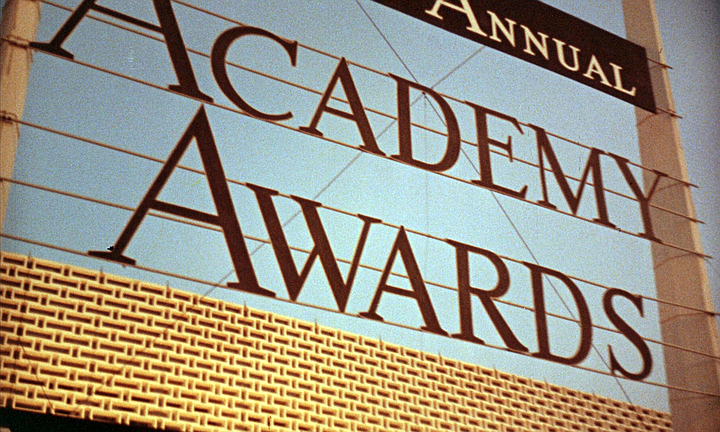
It is remembered by all who see it as Tony Bennett’s first and last dramatic performance. One look, and it’s obvious that when it comes to acting, Bennett can croon with the best of them. On screen, a potato in a suit couldn’t have been any less expressive than Bennett’s Hymie Kelly. The screenplay, written by lauded science-fiction scribe Harlan Ellison, is quite literally perfectly awful, with dialogue so ripe it falls with a thud before you can pick it. But the show belongs to Frank Fane (Stephen Boyd), a shitheel to all who know and love him. Starting out as a stock boy in the Garment District, Fane now finds himself perched atop a glass mountain called success, and nothing will stand in his way of winning Oscar® gold. Why is it called The Oscar? In part because Boyd, the patron saint of ham actors, plays his heart out to win one, duking it out with diction, the only performer on record in need of three syllables to pronounce “lie.”

With the Academy’s dispensation behind him, Levine set out to produce a film destined to rip open Hollywood’s underbelly and in doing so, take home a few Oscars. In addition to employing the best below-the-line talent Paramount had to offer, Levine hired for his cinematographer four-time Academy Award-winner Joseph Ruttenberg. A powerhouse at M-G-M in the 30’s and 40’s (Three Comrades, Woman of the Year, Gaslight), Ruttenberg had of late been mucking out Leo’s backside, squandering his talent on the worst Elvis (It Happened at the World’s Fair) and Bob Hope (A Global Affair) had to offer. The Oscar followed Harlow as the second and final collaboration between cinematographer and producer. It would be Ruttenberg’s penultimate production before Speedway killed him.
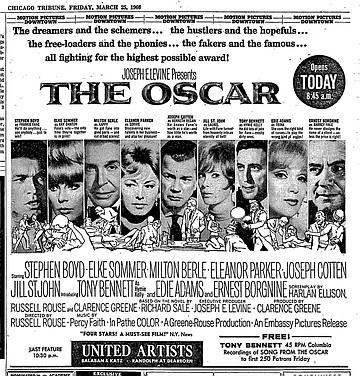
The watchword is authenticity and what better way to showcase it than by having Johnny Grant kick off the festivities. Grant was a TinselTown luminary who for years fancied himself “Honorary Mayor of Hollywood.” He's working the pregame arrivals when Frankie, the front-runner to take home the evening’s Best Actor trophy, steps out of his Rolls Royce and onto the red carpet. We enter the Santa Monica Civic Auditorium to the tune of “Thanks for the Memories.” Bob Hope hosted the show a record 19 times, y'know. Say what you might about his cue card-powered monologues, the guy was at least a movie star unlike Johnny Carson and Jimmy Kimmel. There's Hymie in the crowd, the only one in the room not facing forward. As he sits shooting daggers from the row behind Frankie, one can practically hear director Russell Rouse's response when Bennett asks for his motivation: “Face left, Tony. No, the other left.”
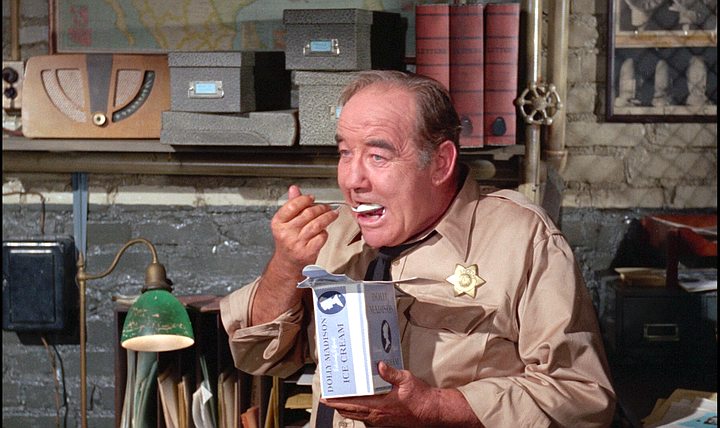
From the outset, Hymie appears content to live life as nothing more than an extra nose on Fane’s face. He devotes his life to trailing Frankie’s circus with a shovel, scooping away whatever crap follows in the star’s wake. (Hymie plays Pence to Frankie's Donald.) Frankie began as a spieler in strip clubs. Hymie’s job is dropping the needle on the record that accompanies the hip-switching Miss Laurel (Jill St. John). (No one has yet to master the art of merging acting with pacing quite like Ms. St. John.) Hymie is in the room when Frankie and Laurel fight, but rather than speak up, he's content to blend in with the couch. About the name: when the boys are later booked on prostitution and procuring, Sheriff Broderick Crawford questions its origins from behind a half gallon of vanilla ice cream. The sheriff’s pronunciation as he asks where he got the name “Hymie” oozes antisemitism. It almost causes Bennett to emit an expression. For the record, Hymie's father was Timothy Kelly, his mother, Sadie Rabinowitz.

Hymie is a doormat with Frankie’s bootprints permanently wiped across him. It’s easy to hate Fane, but even more difficult to like Hymie. When Frankie has a knife drawn on him, where’s friend Hymie? Cowering in a corner while Frankie throws enough punches to save the both of them. Hymie invites Frankie to an unforgettable scene being thrown in Greenwich Village, where he’s introduced to Kay Bergdahl (Elke Sommer). Hymie enters the patio where Frankie and Kay schmooze, his hands burdened with two plates of pasta. Frankie relieves him of both servings and hands one to Kay, sending Hymie back to the buffet to scrounge up another plate for himself. What kind of twisted soul whines as he pimps for his boss, only to take up with Frankie’s sloppy seconds? Hymie’s marriage to Laurel ends when she dies giving birth to Frankie’s baby, and there’s a strong indication that when it’s over, Kay will be the second Mrs. Kelly.
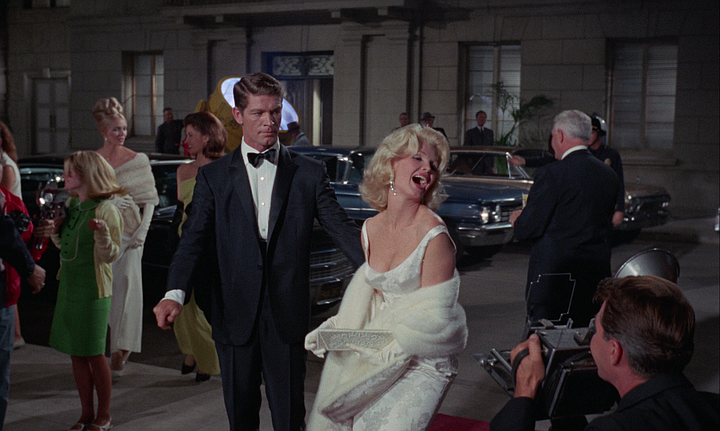
Unless your local television station owned a print or you were fortunate enough to snag an out-of-print VHS tape, copies of which once fetched over $100 on eBay, the film was impossible to find. I was blessed to have a friend who owned a 16mm print that had yet to fade to blue, a quality inherent in films shot in Pathe(tic) Color. The Egyptian screened it almost 20 years ago and other than a complete loss of color, the print was in tip-top shape. Elke Sommer was in attendance and when pressed, she told the crowd that everyone involved in the production knew it was “a piece of shit.” I find that impossible to believe. Half the fun is the conviction each cast member pours into his or her line readings. They believed they were involved in a picture destined to blow the lid off Hollywood’s biggest night. Instead, unintentional howls blew the roofs off theatres.
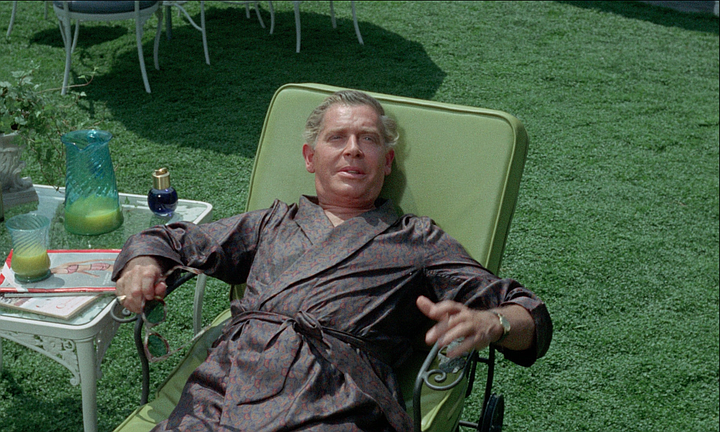
Rather than scramble for screen time just as he does in It’s a Mad, Mad, Mad, Mad World, Milton Berle humbles himself as Frankie’s manager, Kappy Kapsteader. Next to Hymie, Kappy absorbs the most amount of Frankie’s abuse. Unlike Hymie, Kappy has the guts to serve Frankie a platter of just desserts. Having seen the film almost as many times as I have Citizen Kane, there are long passages committed to memory. None bring more delight to recite than Kappy’s “Moth Smashed Against a Windshield” poolside farewell to Frankie. Berle’s Best in Show performance is seconded by Edie Adams’ Trina Yale. Trina and her private dick soon-to-be-ex Barney (Ernest Borgnine) first meet Frankie and Kay at the bullfights in Tijuana. In order to gain voter’s sympathy, Frankie wages a smear campaign against himself. When Fane decides to “blow the whistle on myself,” he hires Yale to leak squalid tales from Frankie and Hymie’s past. When Barney double-crosses Frankie, it’s Trina who spills the beans on Barney’s Swiss Bank Accounts.
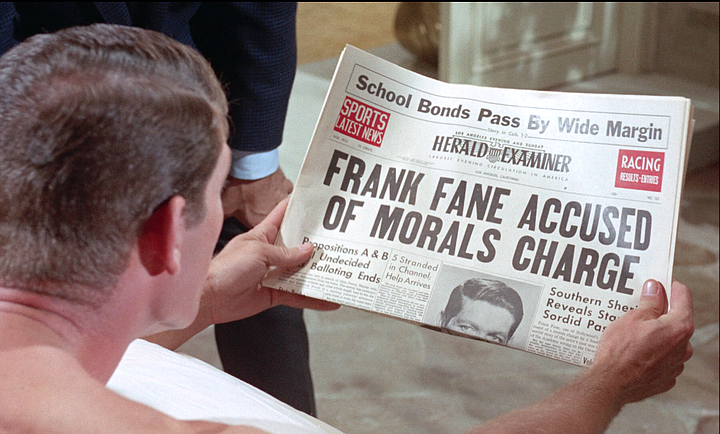
It ends on two strokes of genius. Watching Hymie's cathartic meltdown one almost feels sorry for Bennett, the same way one would cringe during a grade school talent show. In the weeks leading up to the film's release, one wonders how many public relations flacks assured Bennett that his performance had "Oscah" written all over it. This is followed by a watery dissolve that returns us to Frankie's glass mountain. The major players sit waiting for the winner's name to be announced. Presenter Merle Oberon opens the envelope and announces the winner is “Frank…” In the time it takes for “Sinatra” to get out, Fane has started a standing ovation for the Chairman of the Board.
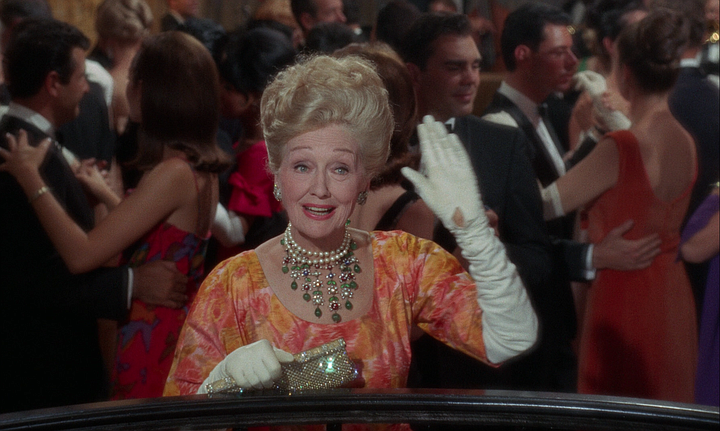
In my marathon rant on The Carpetbaggers, I hinted that Levine might have recycled patches of the Harold Robbins blockbuster to add sizzle to The Oscar. Jonas’ abrupt post-coital split from Rina’s bedroom prefigures Frankie’s “old lady” exodus. Monica and Laurel give birth to children that Jonas and Frankie assume were fathered by others. Bar mirrors make perfect targets for hurtled cocktail glasses. In an effort to get their pictures in the gossip columns, their respective studios connect Jonas and Frankie with popular starlets. In each case, adoring autograph seekers slight the ingenues to get the signature of their handsome escorts.
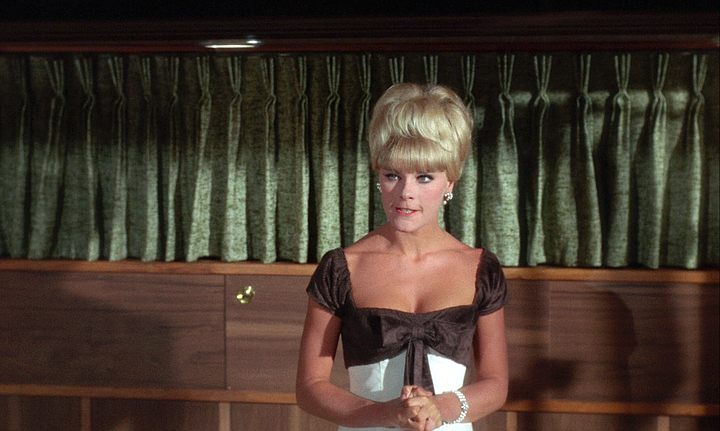
The quickest way to Rina and Kay’s hearts is through sexual degradation. Rina begs Jonas, her former boyfriend and the son of her recently deceased husband — to get the revenge-sex over with. “The more it hurts, the nicer it is,” Jonas cruelly observes. For now, Jonas’ best method of torture is abstinence. Treat her badly and she’ll dig you madly, but don’t give her what she really wants. Kay Bergdahl is more virgin than tramp. Frankie is quick to correct her argument: he’s not everything she loathes, he’s everything she loves.
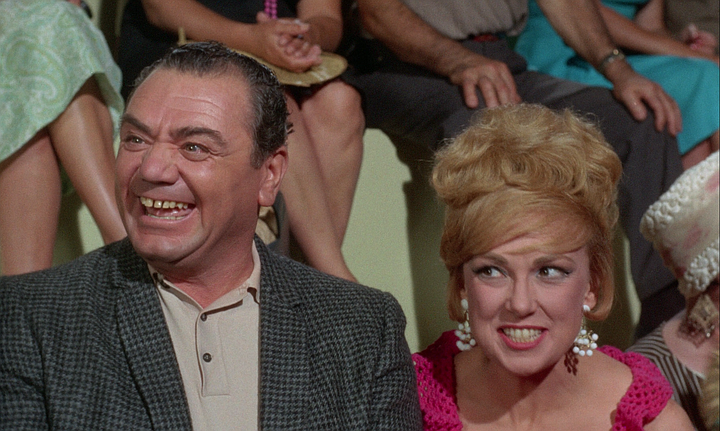
And the winner is… anyone smart enough to invest in Kino Lorber's blu-ray pressing of one of the funniest pictures ever made. Fortunately, none of the participants knew it at the time. What follows is a photo essay of sorts taking us through the various characters and influences. The deal struck between Paramount and producer Joseph E. Levine to produce three adaptations of Harold Robbins best-sellers prevailed during the making of The Oscar. The backlot that stands in for Galaxy Production is clearly Paramount. There are sets, themes, and compositions galore left over from The Carpetbaggers, in addition to props and settings originally found in The Nutty Professor. It's thrombo time!
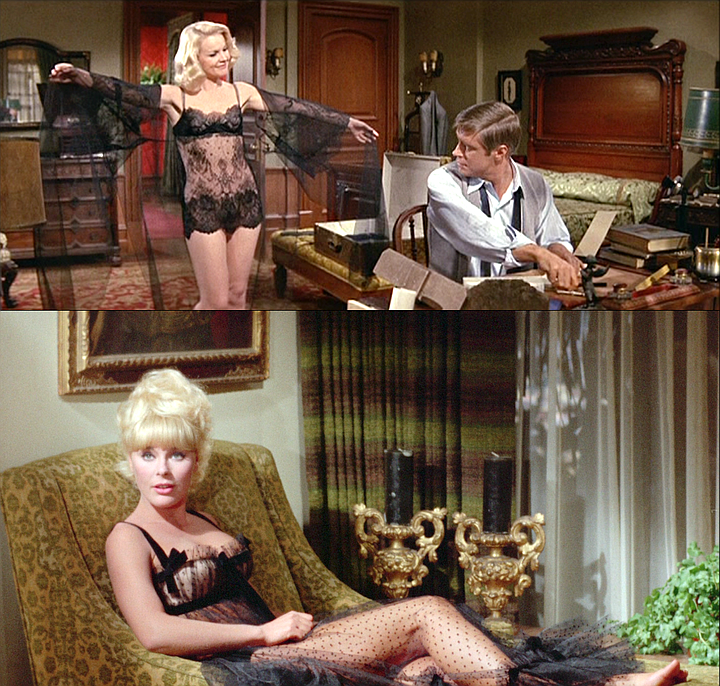
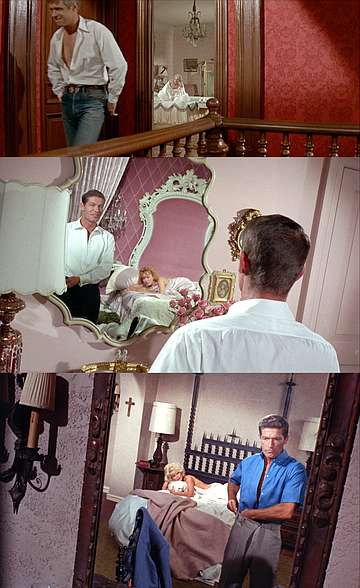
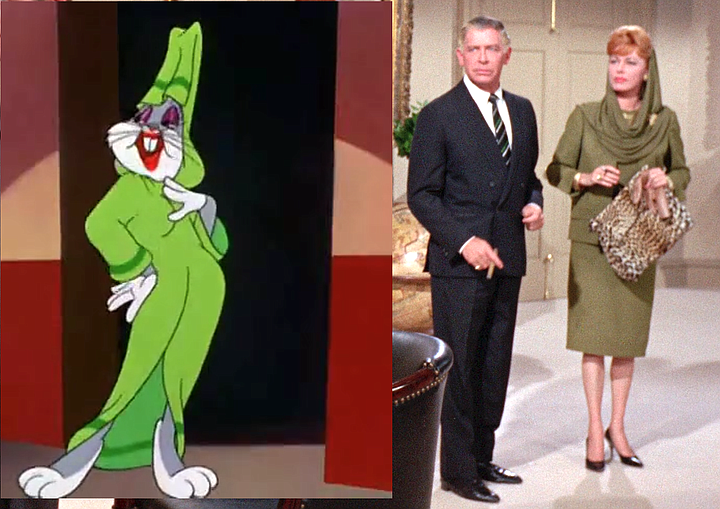
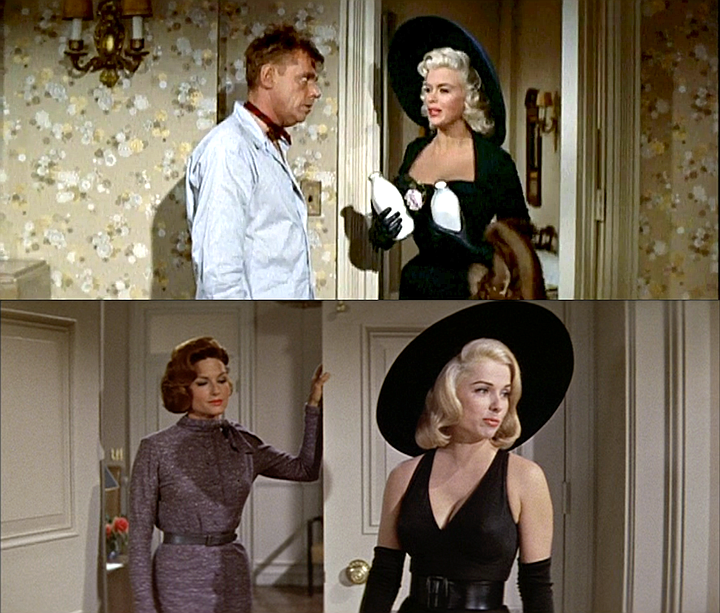
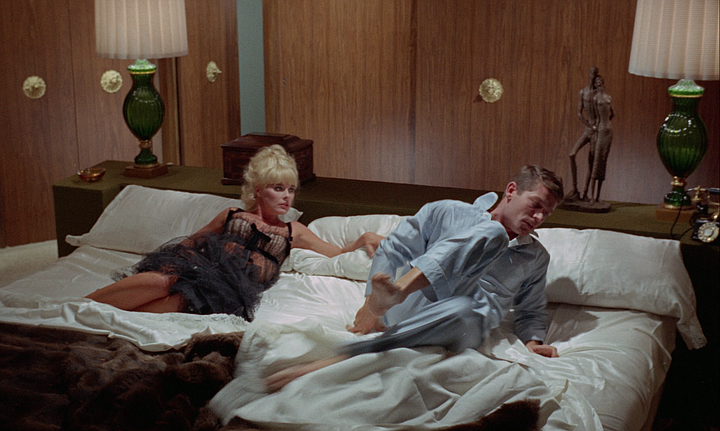
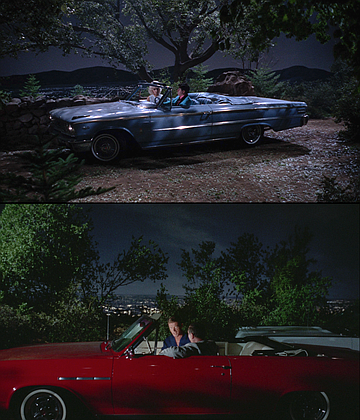

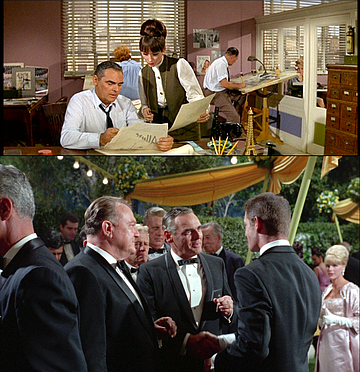

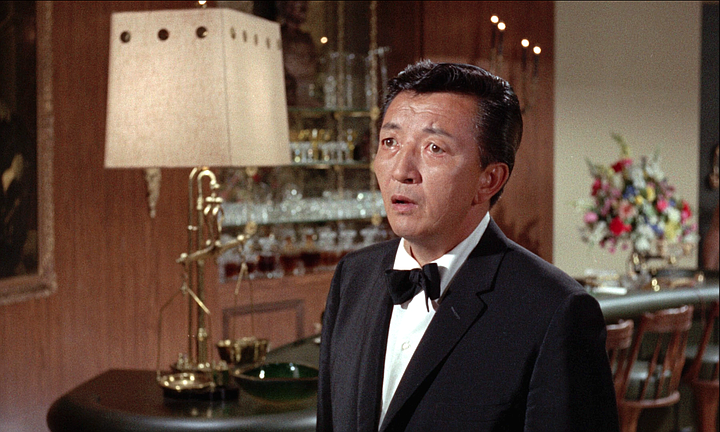
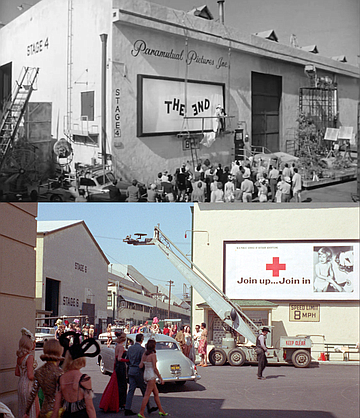


What can be said of an ensemble drama in which Milton Berle gives the best performance? Or a searing indictment of the Oscars that couldn’t have been made without producer Joseph E. Levine first obtaining the Academy’s permission to use the likeness of their golden doorstop? (The Academy has since expressed its profound regret.) Even Bob “Passover” Hope is on hand to emcee the mock ceremony that bookends the picture.
The Oscar (1966)

It is remembered by all who see it as Tony Bennett’s first and last dramatic performance. One look, and it’s obvious that when it comes to acting, Bennett can croon with the best of them. On screen, a potato in a suit couldn’t have been any less expressive than Bennett’s Hymie Kelly. The screenplay, written by lauded science-fiction scribe Harlan Ellison, is quite literally perfectly awful, with dialogue so ripe it falls with a thud before you can pick it. But the show belongs to Frank Fane (Stephen Boyd), a shitheel to all who know and love him. Starting out as a stock boy in the Garment District, Fane now finds himself perched atop a glass mountain called success, and nothing will stand in his way of winning Oscar® gold. Why is it called The Oscar? In part because Boyd, the patron saint of ham actors, plays his heart out to win one, duking it out with diction, the only performer on record in need of three syllables to pronounce “lie.”

With the Academy’s dispensation behind him, Levine set out to produce a film destined to rip open Hollywood’s underbelly and in doing so, take home a few Oscars. In addition to employing the best below-the-line talent Paramount had to offer, Levine hired for his cinematographer four-time Academy Award-winner Joseph Ruttenberg. A powerhouse at M-G-M in the 30’s and 40’s (Three Comrades, Woman of the Year, Gaslight), Ruttenberg had of late been mucking out Leo’s backside, squandering his talent on the worst Elvis (It Happened at the World’s Fair) and Bob Hope (A Global Affair) had to offer. The Oscar followed Harlow as the second and final collaboration between cinematographer and producer. It would be Ruttenberg’s penultimate production before Speedway killed him.

The watchword is authenticity and what better way to showcase it than by having Johnny Grant kick off the festivities. Grant was a TinselTown luminary who for years fancied himself “Honorary Mayor of Hollywood.” He's working the pregame arrivals when Frankie, the front-runner to take home the evening’s Best Actor trophy, steps out of his Rolls Royce and onto the red carpet. We enter the Santa Monica Civic Auditorium to the tune of “Thanks for the Memories.” Bob Hope hosted the show a record 19 times, y'know. Say what you might about his cue card-powered monologues, the guy was at least a movie star unlike Johnny Carson and Jimmy Kimmel. There's Hymie in the crowd, the only one in the room not facing forward. As he sits shooting daggers from the row behind Frankie, one can practically hear director Russell Rouse's response when Bennett asks for his motivation: “Face left, Tony. No, the other left.”

From the outset, Hymie appears content to live life as nothing more than an extra nose on Fane’s face. He devotes his life to trailing Frankie’s circus with a shovel, scooping away whatever crap follows in the star’s wake. (Hymie plays Pence to Frankie's Donald.) Frankie began as a spieler in strip clubs. Hymie’s job is dropping the needle on the record that accompanies the hip-switching Miss Laurel (Jill St. John). (No one has yet to master the art of merging acting with pacing quite like Ms. St. John.) Hymie is in the room when Frankie and Laurel fight, but rather than speak up, he's content to blend in with the couch. About the name: when the boys are later booked on prostitution and procuring, Sheriff Broderick Crawford questions its origins from behind a half gallon of vanilla ice cream. The sheriff’s pronunciation as he asks where he got the name “Hymie” oozes antisemitism. It almost causes Bennett to emit an expression. For the record, Hymie's father was Timothy Kelly, his mother, Sadie Rabinowitz.

Hymie is a doormat with Frankie’s bootprints permanently wiped across him. It’s easy to hate Fane, but even more difficult to like Hymie. When Frankie has a knife drawn on him, where’s friend Hymie? Cowering in a corner while Frankie throws enough punches to save the both of them. Hymie invites Frankie to an unforgettable scene being thrown in Greenwich Village, where he’s introduced to Kay Bergdahl (Elke Sommer). Hymie enters the patio where Frankie and Kay schmooze, his hands burdened with two plates of pasta. Frankie relieves him of both servings and hands one to Kay, sending Hymie back to the buffet to scrounge up another plate for himself. What kind of twisted soul whines as he pimps for his boss, only to take up with Frankie’s sloppy seconds? Hymie’s marriage to Laurel ends when she dies giving birth to Frankie’s baby, and there’s a strong indication that when it’s over, Kay will be the second Mrs. Kelly.

Unless your local television station owned a print or you were fortunate enough to snag an out-of-print VHS tape, copies of which once fetched over $100 on eBay, the film was impossible to find. I was blessed to have a friend who owned a 16mm print that had yet to fade to blue, a quality inherent in films shot in Pathe(tic) Color. The Egyptian screened it almost 20 years ago and other than a complete loss of color, the print was in tip-top shape. Elke Sommer was in attendance and when pressed, she told the crowd that everyone involved in the production knew it was “a piece of shit.” I find that impossible to believe. Half the fun is the conviction each cast member pours into his or her line readings. They believed they were involved in a picture destined to blow the lid off Hollywood’s biggest night. Instead, unintentional howls blew the roofs off theatres.

Rather than scramble for screen time just as he does in It’s a Mad, Mad, Mad, Mad World, Milton Berle humbles himself as Frankie’s manager, Kappy Kapsteader. Next to Hymie, Kappy absorbs the most amount of Frankie’s abuse. Unlike Hymie, Kappy has the guts to serve Frankie a platter of just desserts. Having seen the film almost as many times as I have Citizen Kane, there are long passages committed to memory. None bring more delight to recite than Kappy’s “Moth Smashed Against a Windshield” poolside farewell to Frankie. Berle’s Best in Show performance is seconded by Edie Adams’ Trina Yale. Trina and her private dick soon-to-be-ex Barney (Ernest Borgnine) first meet Frankie and Kay at the bullfights in Tijuana. In order to gain voter’s sympathy, Frankie wages a smear campaign against himself. When Fane decides to “blow the whistle on myself,” he hires Yale to leak squalid tales from Frankie and Hymie’s past. When Barney double-crosses Frankie, it’s Trina who spills the beans on Barney’s Swiss Bank Accounts.

It ends on two strokes of genius. Watching Hymie's cathartic meltdown one almost feels sorry for Bennett, the same way one would cringe during a grade school talent show. In the weeks leading up to the film's release, one wonders how many public relations flacks assured Bennett that his performance had "Oscah" written all over it. This is followed by a watery dissolve that returns us to Frankie's glass mountain. The major players sit waiting for the winner's name to be announced. Presenter Merle Oberon opens the envelope and announces the winner is “Frank…” In the time it takes for “Sinatra” to get out, Fane has started a standing ovation for the Chairman of the Board.

In my marathon rant on The Carpetbaggers, I hinted that Levine might have recycled patches of the Harold Robbins blockbuster to add sizzle to The Oscar. Jonas’ abrupt post-coital split from Rina’s bedroom prefigures Frankie’s “old lady” exodus. Monica and Laurel give birth to children that Jonas and Frankie assume were fathered by others. Bar mirrors make perfect targets for hurtled cocktail glasses. In an effort to get their pictures in the gossip columns, their respective studios connect Jonas and Frankie with popular starlets. In each case, adoring autograph seekers slight the ingenues to get the signature of their handsome escorts.

The quickest way to Rina and Kay’s hearts is through sexual degradation. Rina begs Jonas, her former boyfriend and the son of her recently deceased husband — to get the revenge-sex over with. “The more it hurts, the nicer it is,” Jonas cruelly observes. For now, Jonas’ best method of torture is abstinence. Treat her badly and she’ll dig you madly, but don’t give her what she really wants. Kay Bergdahl is more virgin than tramp. Frankie is quick to correct her argument: he’s not everything she loathes, he’s everything she loves.

And the winner is… anyone smart enough to invest in Kino Lorber's blu-ray pressing of one of the funniest pictures ever made. Fortunately, none of the participants knew it at the time. What follows is a photo essay of sorts taking us through the various characters and influences. The deal struck between Paramount and producer Joseph E. Levine to produce three adaptations of Harold Robbins best-sellers prevailed during the making of The Oscar. The backlot that stands in for Galaxy Production is clearly Paramount. There are sets, themes, and compositions galore left over from The Carpetbaggers, in addition to props and settings originally found in The Nutty Professor. It's thrombo time!










